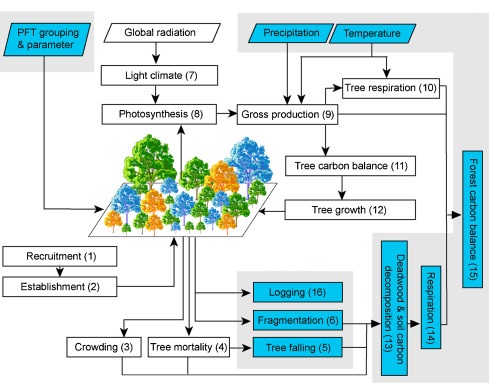MAIN PROCESSES OF FORMIND

Forest dynamics are simulated on different scales: (i) area-level (e.g., 10 ha), (ii) patch-level (20m x 20m) or (iii) on the level of an individual tree.
For species-rich forests, e.g. tropical rain forests, an aggregation of species into functional groups is useful. Depending on the site, we group species in up to 19 different plant functional types. Typically, we use two criteria for this grouping: light demands (e.g. shade intolerant pionner and shade tolerant climax species) and maximum tree height layer (e.g. understory, canopy, emergent). However, we are able to define any number of ecologically significant groups through parametrization (e.g. seed dispersal syndrome and water tolerance).
Within each time step, the following main processes can be calculated:
Seeds are distributed over the forest area. If light conditions are suitable, a new individual can establish and competes for light and space in its patch.
The growth of an individual is determined by its gross primary productivity (GPP), respiration and type-specific physiological parameters.
An individual can die and this process is described by a specific mortality rate. If one tree falls, neighboring trees of its patch can be damaged as well. Additional mortality occur due to crowding (e.g., in dense stands) or poor fitness.
One of the main driving factor of the model is light. Formind calculate the light condition in different height layers of the forest. Light decreases within the forest in order to include competition of light between individuals. Depending on its latitude, forest dynamics can be influenced by additional climatic factors like precipitation and temperature.
FORMIND includes different types of disturbances like fire events, landslides, logging and fragmentation.
The model calculates the gross primary production (GPP), growth and maintenance respiration, and net primary production (NPP) for each tree. Based on carbon stocks and fluxes between atmosphere, forest stand and soil, a whole carbon balance of a forest stand can be derived.
